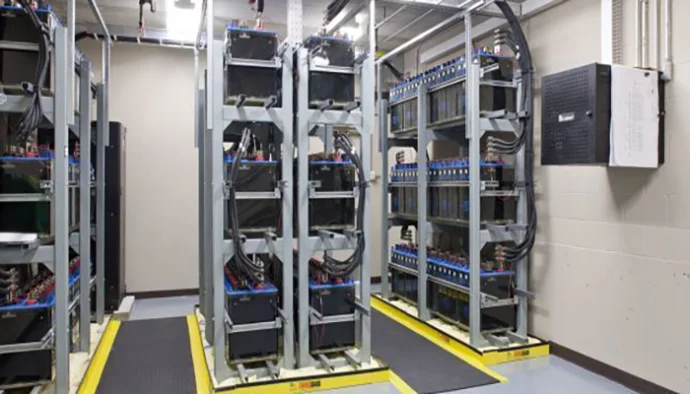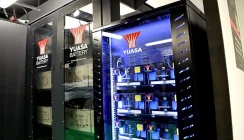A Guide To Replacing Lead Acid UPS Batteries In A Datacentre
Over 80% of all uninterruptible power supply service issues are battery related. UPS batteries age whether in use or in storage. This is because a battery stores electrical energy using a chemical process and their working life is dependent upon a number of factors including: charge/discharge cycles, operational temperature, charging technique and their overall design and build quality.
UPS Battery Design Life
All batteries have a design life and it is important to know this when deciding which uninterruptible power supply to purchase. This then allows for their planned replacement and upgrade as well as defining testing and inspection intervals during their working lives.
Most UPS system batteries are of the sealed Lead Acid Valve Regulated (VRLA) type with a 5-year or 10-year design life. Some industrial lead acid batteries are available with 15 and 20-year design lives. The quoted design life should be taken as a projected working lifetime over which battery performance will degrade.
Approaching their end-of-life a UPS VRLA battery may only be able to provide 70-80% or less of its original performance. For this reason, UPS battery replacement times is another factor to consider when selecting a UPS. For 5-year batteries the typical replacement is within 3-5 years and for a 10-year design life battery around 7-8 years.
UPS systems using Lithium-ion batteries are available and are a spin-off development from energy storage systems. Li-ion batteries can have a longer working life 10 years or more and are more suited to rapid charge/discharge cycles. The reason why lead acid batteries are preferred for UPS applications is the lower cost and relatively lower-tech battery management requirements.
Lead acid battery performance degrades for several reasons. In an uninterruptible power supply, the battery set is used in a standby power application. The battery is charged and only called on to discharge when there is a power outage or momentary break in supply. Once the power problem has rectified, the battery is recharged. VRLA batteries have a typical charge/discharge cycled life expectancy of around 300-400 cycles. This type of battery is also affected by ambient temperature. The ideal ambient is 20-25˚C and for every 1˚ rise above 30˚C the design life halves.
UPS Battery Testing
A UPS system will typically be set to auto-test its battery set every 24hours. This will test the overall battery performance and voltage with a partial self-discharge. The only way to ensure that the battery set can deliver the runtime performance specified would be to use a load bank (to simulate the actual load) and time how long the battery lasts for once the mains power supply input has been removed.
UPS batteries can also be tested by a trained engineer using a hand-held battery block tester. This will use probes to connect/touch to the battery terminals to take readings for conductance, sulfation and impedance. The measurements can then be automatically compared to previous results and potential drops used to identify overall battery age and remaining performance.
Large UPS systems may also be installed with a complete battery monitoring system. This will consist of devices connected to each battery that constantly monitor and report the findings to a central unit. The central unit will then analyse the results either on-site or via a Cloud based server and portal, and again report on the overall battery block age and potential performance.
Replacement UPS Batteries
Within a battery set it is not uncommon to find variations in overall battery block health. If the battery set is new (within 1 year) it may be possible to replace a failed battery without damage to the entire battery string. This should be verified with the battery manufacturer. For older battery strings the accepted best practice is the replacement of the entire battery set. The reason for this is that a battery string will be limited by the performance of its weakest battery. In addition, new replacement batteries will eventually degrade down to the level of the weakest battery block.
To achieve the specified runtime, batteries should always be replaced with a like-for-like rating (Vdc, Ampere-hour, Ah and design life) and should all be from the same range and manufacturer. For small UPS systems up to 10kVA, battery replacement kits and cartridges may be available. For other and larger UPS systems the battery blocks may be larger and require replacement into an existing cabinet or onto an existing server rack.
Plug-in replacement battery cartridges help to de-skill the replacement process but should only be handled where there are no risks in terms of manual handling or the electrical connections. Individual battery block replacement should be carried out by a suitably qualified engineer trained to work in both DC and AC environments.
Following replacement, the old battery set should be taken to a certified WEEE/RoHS centre for strip down and recycling where components: plastic, lead plates, hydrochloric acid electrolyte can be reclaimed.
Summary
Server Room Environments provide a range of replacement UPS batteries including plug-in replacement battery kits and individual UPS battery blocks. Our team can also provide complete project management including individual battery block testing, removal and environmentally friendly disposal.


























